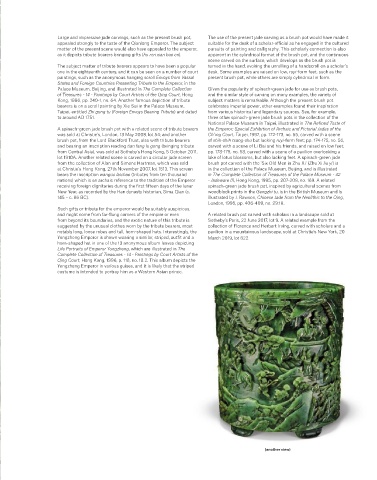Page 297 - Christies IMportant Chinese Art Sept 26 2020 NYC
P. 297
Large and impressive jade carvings, such as the present brush pot, The use of the present jade carving as a brush pot would have made it
appealed strongly to the taste of the Qianlong Emperor. The subject suitable for the desk of a scholar-official as he engaged in the cultured
matter of the present scene would also have appealed to the emperor, pursuits of painting and calligraphy. This scholarly connection is also
as it depicts tribute bearers bringing gifts (hu ren xian bao en). apparent in the cylindrical format of the brush pot, and the continuous
scene carved on the surface, which develops as the brush pot is
The subject matter of tribute bearers appears to have been a popular turned in the hand, evoking the unrolling of a handscroll on a scholar’s
one in the eighteenth century, and it can be seen on a number of court desk. Some examples are raised on low, ruyi-form feet, such as the
paintings, such as the anonymous hanging scroll Envoys from Vassal present brush pot, while others are simply cylindrical in form.
States and Foreign Countries Presenting Tribute to the Emperor, in the
Palace Museum, Beijing, and illustrated in The Complete Collection Given the popularity of spinach-green jade for use as brush pots,
of Treasures - 14 - Paintings by Court Artists of the Qing Court, Hong and the similar style of carving on many examples, the variety of
Kong, 1996, pp. 240-1, no. 64. Another famous depiction of tribute subject matters is remarkable. Although the present brush pot
bearers is on a scroll painting by Xie Sui in the Palace Museum, celebrates imperial power, other examples found their inspiration
Taipei, entitled Zhi gong tu (Foreign Envoys Bearing Tribute) and dated from various historical and legendary sources. See, for example,
to around AD 1751. three other spinach-green jade brush pots in the collection of the
National Palace Museum in Taipei, illustrated in The Refined Taste of
A spinach-green jade brush pot with a related scene of tribute bearers the Emperor: Special Exhibition of Archaic and Pictorial Jades of the
was sold at Christie’s, London, 13 May 2008, lot 54; and another Ch’ing Court, Taipei, 1997, pp. 172-173, no. 55, carved with a scene
brush pot, from the Lord Blackford Trust, also with tribute bearers of shih-shih tsang-shu but lacking ruyi-form feet; pp. 174-175, no. 56,
and bearing an inscription reading tian fang lu gong (bringing tribute carved with a scene of Li Bai and his friends, and raised on low feet;
from Central Asia), was sold at Sotheby's Hong Kong, 5 October 2011, pp. 178-179, no. 58, carved with a scene of a pavilion overlooking a
lot 1910A. Another related scene is carved on a circular jade screen lake of lotus blossoms, but also lacking feet. A spinach-green jade
from the collection of Alan and Simone Hartman, which was sold brush pot carved with the 'Six Old Men in Zhu Xi' (Zhu Xi liu yi) is
at Christie’s Hong Kong, 27th November 2007, lot 1513. This screen in the collection of the Palace Museum, Beijing, and is illustrated
bears the inscription wanguo laichao (tributes from ten thousand in The Complete Collection of Treasures of the Palace Museum - 42
nations) which is an archaic reference to the tradition of the Emperor - Jadeware III, Hong Kong, 1995, pp. 207-208, no. 169. A related
receiving foreign dignitaries during the first fifteen days of the lunar spinach-green jade brush pot, inspired by agricultural scenes from
New Year, as recorded by the Han dynasty historian, Sima Qian (c. woodblock prints in the Gengzhi tu, is in the British Museum and is
145 – c. 86 BC). illustrated by J. Rawson, Chinese Jade from the Neolithic to the Qing,
London, 1995, pp. 406-409, no. 29:18.
Such gifts or tribute for the emperor would be suitably auspicious,
and might come from far-flung corners of the empire or even A related brush pot carved with scholars in a landscape sold at
from beyond its boundaries, and the exotic nature of this tribute is Sotheby’s Paris, 22 June 2017, lot 9. A related example from the
suggested by the unusual clothes worn by the tribute bearers, most collection of Florence and Herbert Irving, carved with scholars and a
notably long, loose robes and tall, horn-shaped hats. Interestingly, the pavilion in a mountainous landscape, sold at Christie’s New York, 20
Yongzheng Emperor is shown wearing a similar, striped, outfit and a March 2019, lot 822.
horn-shaped hat in one of the 13 anonymous album leaves depicting
Life Portraits of Emperor Yongzheng, which are illustrated in The
Complete Collection of Treasures - 14 - Paintings by Court Artists of the
Qing Court, Hong Kong, 1996, p. 118, no. 18.2. This album depicts the
Yongzheng Emperor in various guises, and it is likely that the striped
costume is intended to portray him as a Western Asian prince.
(another view)

